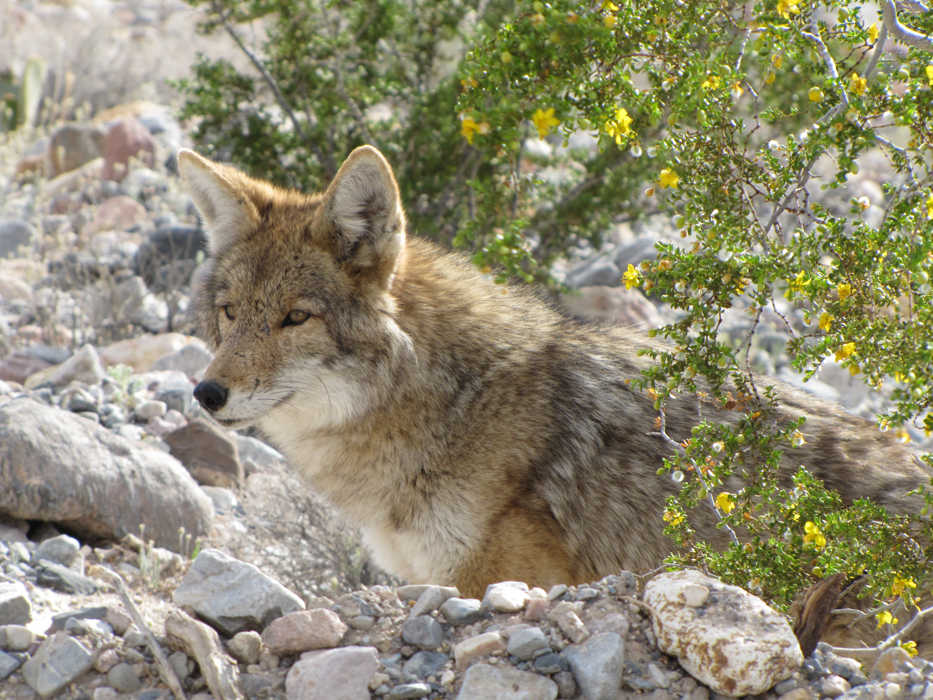Coyotes are perhaps the most adaptable carnivore in North America, ranging from the Atlantic to the Pacific coasts and from Central America north to Interior Alaska. They live in remote wilderness areas as well as urban areas, and have been seen in city parks in New York, Chicago and Los Angeles.
When coyotes began moving north and were first reported on the Kenai Peninsula in the early 1900s, they found the peninsula free of wolves and thus colonized it without having to compete with their larger aggressive cousins. But concern then about the widespread presence of coyotes on the peninsula resulted in bounties placed on coyotes and, combined with the value of their pelts, provided a source of winter income for trappers on the peninsula in the 1930s and 1940s. By the 1960s, wolves from mainland Alaska began to naturally re-colonize the Kenai after having been extirpated for nearly a half-century, only to discover that coyotes had become well established in their absence.
When Dr. Rolf Peterson and Jim Woolington began, and I later joined, the Kenai Peninsula’s first wolf study, radio collars were also fitted on coyotes incidentally-captured from 1976 to 1980 on the Kenai National Moose Range (later to become the Kenai National Wildlife Refuge). At that time coyote home ranges overlapped those of wolves and averaged 40.1 and 27.8 square miles for male and female coyotes, respectively. Coyotes ate primarily snowshoe hares, porcupines and other small mammals. Coyotes were captured more often near public roads than near roads closed to public access likely because of interference competition with wolves. During that study, eight instances of wolves killing coyotes were documented.
Later, from 1987 to 1991, University of Alaska Fairbanks graduate student Win Staples conducted research on coyotes and lynx on the Refuge when the snowshoe hare population was low. He discovered that although coyotes continued to feed on scarce hares, coyotes fed primarily by scavenging carcasses of moose that were often killed by wolves during winter. This behavior often brought coyotes in direct contact with wolves and, as in the earlier study, Staples reported that three of his sixteen radio-collared coyotes whose fates were known had been killed by wolves and four by humans. Thus, given the opportunity, wolves will kill coyotes (but usually do not eat them). Not surprisingly, coyotes learn to avoid wolves but may also become dependent on them for food in the form of moose carcasses.
Staples also reported that coyotes scavenged from the carcass of a moose that was injured when struck by a vehicle and wandered off the road before dying. Coyotes also scavenged on spawned-out salmon carcasses along the Kenai River, and occasionally killed small free-roaming (unpenned) domestic ducks and rabbits, and killed and partially ate two dogs (cocker spaniel and beagle) in the off-refuge, human-developed Sterling Corridor.
In addition to co-existing with wolves on the Refuge, coyotes on the northern peninsula also inhabit areas outside the Refuge seldom used by packs of wolves such as the Sterling Corridor and other human-dominated areas around Soldotna, Kenai and Nikiski and the Kenai River Flats where they are sometimes mistaken for wolves.
Once while radio-tracking wolves from an aircraft, I observed a coyote approaching a pack of wolves unware they were just behind a nearby ridge and thus unseen by the coyote. The wolves immediately pursued the approaching coyote when they first spotted it. However, the fast running coyote outdistanced the wolves which just as quickly abandoned the chase. Had the snow been deeper and the coyote unable to run as swiftly, the outcome may have been different.
Elsewhere, a study of coyotes and wolves in Yellowstone National Park revealed that after wolves were introduced there in 1995, 75 percent of 337 observed wolf-coyote interactions occurred at ungulate carcass sites, and that wolves initiated 85 percent of the encounters, dominating most of the interactions. Wolves chased coyotes without physical contact 79 percent of the time and killed coyotes only during 7 percent of the interactions. Other findings were that wolf-coyote interactions decreased over time, wolves were the dominant canid, and coyotes probably benefit from the access to carrion at wolf-killed carcasses.
Coyotes now live in most habitats in North America including those dominated by humans and among wolves, their most significant natural competitor, but it can be a dangerous life. Fortunately for coyotes, they are one of the nature’s supreme adaptors.
Dr. Ted Bailey is a retired Kenai National Wildlife Refuge wildlife biologist who has lived on the Kenai Peninsula for over 40 years. He maintains a keen interest in our local wildlife and natural history.

